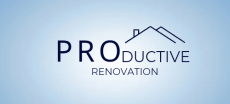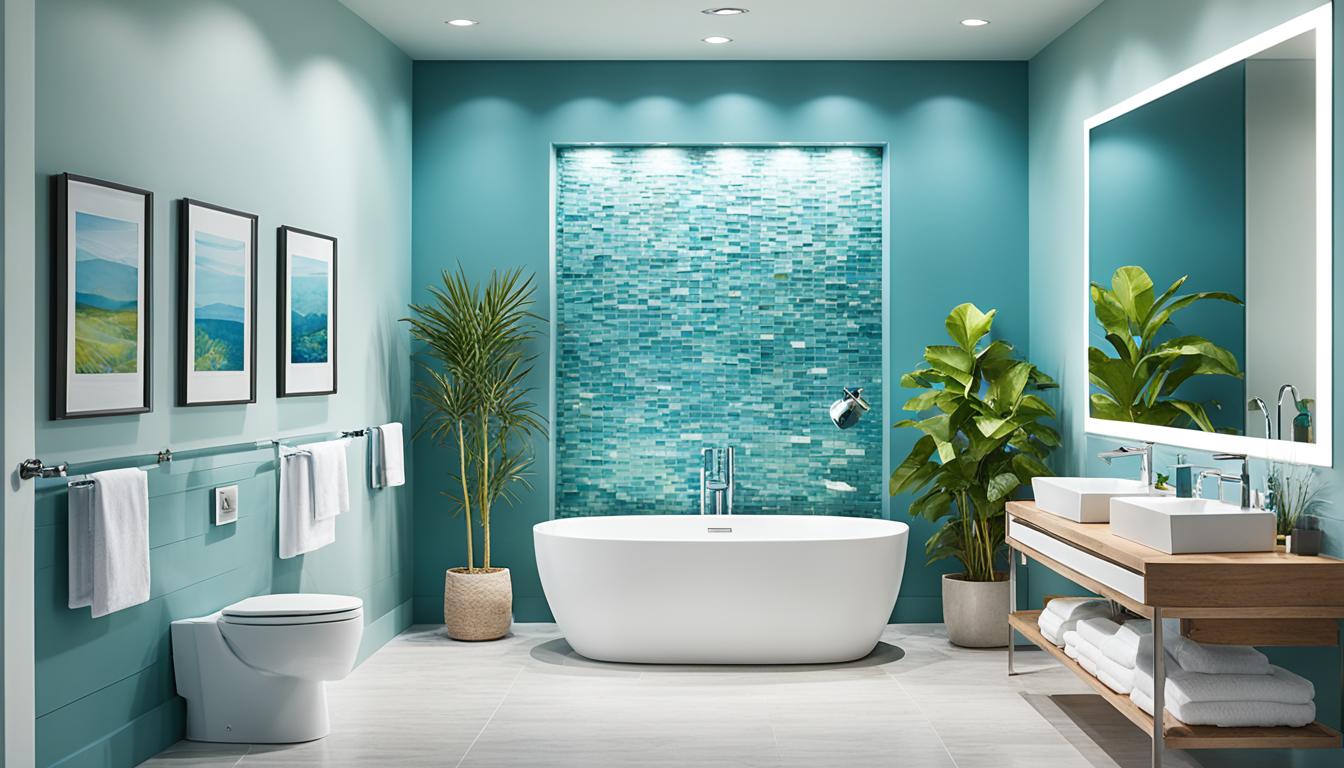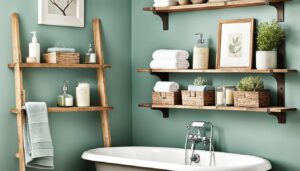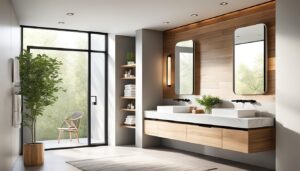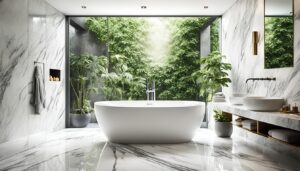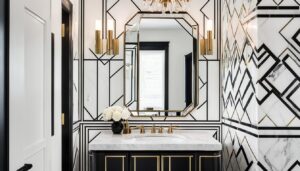Did you know your bathroom could be using lots of energy and water? This can make your bills higher. Making your bathroom energy-efficient is more than just making it look good. It means choosing things that save money and help the planet. Did you know using LED lights can cut energy use by up to 80%1? Changing your bathroom to be eco-friendly adds value to your home. It also shows you care about the environment. This is part of a bigger trend towards green bathroom makeovers.
Key Takeaways
- Understanding the importance of energy efficiency can transform your bathroom.
- Implementing energy-saving fixtures can significantly reduce utility bills.
- Eco-friendly materials contribute to a sustainable home environment.
- Smart technologies can enhance convenience while saving energy.
- Incentives are available for making energy-efficient upgrades.
- Water conservation techniques can lead to substantial savings.
Understanding the Importance of an Energy-Efficient Bathroom
An energy-efficient bathroom helps cut down on how much energy a house uses. On average, people in the U.S. use 80 to 100 gallons of water every day. A big part of this happens in the bathroom2. About 25% of a home’s water use comes from flushing the toilet2.
In Texas, 19% of the energy homes use goes towards heating water2. This shows making better use of our bathrooms can really save energy.
Making bathrooms more eco-friendly is key to living in a way that helps the planet. Installing toilets that use less water or have two flush options can greatly reduce water use3. Electronic faucets can save between 50 to 80% more water than old-style ones3. Making these switches shows we’re serious about updating our homes for the better of the environment.
Switching to LED lights not only looks better but is also a move towards reducing energy use. LEDs can last up to 40 times longer than traditional bulbs and use much less power4.
Also, using an ENERGY STAR® exhaust fan in the bathroom can cut down energy use by up to 70%2. Upgrading to these features lowers your bills and helps protect the planet too.
Key Benefits of Energy-Efficient Bathroom Remodels
Opting for an energy-efficient bathroom remodel brings many pluses. Not only does it look good, but it also offers environmental impact benefits by cutting down water and energy use. For example, heating water makes up 18% of a home’s energy use. Making this part better is key for cost-effective remodeling and saving on bills5.
Environmental and Cost Savings
Adding things like low-flow showerheads, which use only 2.5 gallons per minute, can greatly reduce water use. Another way to save water is the “Navy shower” method, which cuts down how much water you use a lot5. Also, WaterSense faucets can use about 30% less water than regular ones. This means lower water bills and better for the planet5.
Leaks in things like faucets waste nearly 10,000 gallons of water a year in a typical house5. Putting in high-efficiency toilets that use just 1.28 gallons per flush can fix this leak issue. These improvements help save money and have a good effect on the environmental impact.
Enhancing Home Value
Having an energy-efficient bathroom helps increase a home’s increased home value. Such updated fixtures draw in buyers who care about the environment. They also make a home stand out in a crowded market. Studies show that updating bathrooms often leads to a good return on investment, making it a smart choice for homeowners6.
Using energy-smart appliances and modern designs makes the home look and feel more welcoming. Besides fixing old issues—like worn electrical systems and mold—it also makes the bathroom safer and healthier6. By focusing on energy efficiency and style in bathroom remodels, homeowners prepare for a greener future while boosting their home’s value.
Planning Your Energy-Efficient Bathroom Remodel
When remodeling your bathroom for energy efficiency, start with a plan. Define your energy savings goals. These should match your vision for a green home. Focus on specific, measurable ways to lower your home’s carbon footprint. And, look at how these changes will reduce your utility bills every month.
Setting Goals for Energy Savings
To make your bathroom remodel effective, set clear energy savings goals. Opt for fixtures that use less water and power. For example, modern showerheads can halve your water use. Water heating makes up to 30% of home energy use7.
Also, target the reduction of energy loss. Traditional tank heaters lose 10-20% of energy as heat7. This happens when they store hot water.
Conducting an Energy Audit
An energy audit is a key step. It finds where your home is losing efficiency. The audit looks at your current fixtures, insulation, and systems. It’s part of a thorough home inspection.
By insulating your hot water pipes, you can greatly reduce heat loss. This can save you about $70 yearly8. Energy-efficient bathroom fans also help. They use 70% less electricity8. The audit points out the best areas for upgrades.
Choosing Energy-Saving Bathroom Fixtures
When you redo your bathroom, choosing fixtures that save energy is key. They help save water and reduce your energy bills. Here are some options to think about:
Low-Flow Toilets
Modern low-flow toilets use less water, following EPA WaterSense standards. They use 1.28 gallons or less per flush. This saves about 23 liters of water each flush, adding up to big savings over time9.
With toilets being a big water user in homes, updating them can cut your water bill. The average home uses 22% of its water just for flushing10.
Low-Flow Showerheads and Faucets
Low-flow showerheads and faucets use less water but keep pressure good. Old showerheads use 5.5 GPM. But, new ones cut this rate, helping you save energy9.
These changes can save thousands of gallons of water a year. This is good for your wallet and the planet10.
Energy Star Appliances
Go for Energy Star appliances like tankless water heaters and fans. They are 30% more efficient than old-style water heaters. This means you save 22% more energy9.
Using these appliances is not only green but also saves money long term.
The integration of energy-saving fixtures in your bathroom remodel can lead to significant reductions in water and energy usage while promoting a sustainable lifestyle.
For more on energy-efficient bathroom fixtures, visit this resource910.
Incorporating Sustainable Materials in Your Remodel
Choosing eco-friendly materials for your bathroom remodel is essential. They lower the environmental impact and make the room look better. Bamboo, cork, and recycled glass tiles cut water use by up to 60% compared to usual materials11. Plus, they last longer against damage, moisture, and stains11.
These green choices improve indoor air by using low VOC paint and cabinets without formaldehyde11. This makes your bathroom’s air healthier to breathe.
Eco-Friendly Bathroom Materials
Bamboo and recycled glass lower the need for new resources by being made from recycled stuff12. Using them for floors and counters helps avoid trash going to dumps12. Adding water-saving fixtures like low-flow toilets shows a real care for the environment. These toilets use much less water12.
Recycled and Reclaimed Products
Using old wood or recycled materials for your bathroom’s cabinets and floors keeps trash out of landfills. It also gives your space its own look12. This recycle-and-reuse approach backs up a sustainable way of building. By recycling things like tiles and cabinets, you cut down on waste and save resources12.
This green building method means your bathroom will have better air. So, it’s a nicer place for you to live12.
| Material Type | Environmental Benefit | Impact on Indoor Quality |
|---|---|---|
| Bamboo | Renewable and reduces deforestation | Low VOC, healthier air quality |
| Recycled Glass Tiles | Minimizes landfill waste | Enhances aesthetics with less environmental impact |
| Reclaimed Wood | Reduces waste, promotes sustainability | Unique character, contributes to healthier spaces |
| Low VOC Paint | Improves indoor air quality | Minimizes harmful toxic emissions |
Lighting Solutions for an Energy-Efficient Bathroom
When redoing a bathroom, great lighting is key for both use and feel. Moving to LED lighting marks a big leap towards more energy-saving lighting. LED bulbs use less power than traditional ones and last much longer. This makes them a green and wallet-friendly option for any bathroom13. These bulbs come with a high color quality index, making them perfect for makeup and grooming tasks13.
Switch to LED Lighting
Going with LED lights cuts down on energy use and can save you a lot on your electric bill. They use way less power in bathrooms compared to old-school bulbs14. Opting for vanity lights with LED tech improves the space’s appeal while being long-lasting14. Mounting lights on both sides of the mirror can reduce shadows, spreading light evenly.
Utilizing Natural Light
Bringing in natural light through windows or skylights can cut down the need for electric lighting. Skylights, especially, can make a big bathroom brighter and less dependent on power-hungry light sources13. Natural light not only boosts visibility but also makes the space more inviting. Using dimmer switches gives you control over light intensity, increasing energy savings even more.
Optimal Ventilation and Heating Practices
Making your bathroom comfy and saving energy is key. Good airflow lowers humidity and stops mold. Choose energy-saving fans for better air and moisture control. Fans last about 10 years, so replace them if they get noisy or don’t remove moisture well15. Installing new fans costs $200 to $80015.
Selecting Energy-Efficient Ventilation Fans
Picking the right fans helps manage air well. Inline fans, placed in ducts away from the bathroom, are quieter. ERVs and HRVs cut energy loss by moving heat or humidity. They keep air fresh and save energy16.
Radiant Floor Heating and Tankless Water Heaters
Radiant floor heating warms floors directly, cutting heating costs. Tankless water heaters give hot water instantly, saving more energy. Both options increase comfort by keeping your home warm and providing endless hot water.
Smart Technologies for Your Bathroom
Adding smart tech to your bathroom boosts comfort and saves energy. Smart thermostats and motion-sensing lights help you use less energy. These features adjust automatically for maximum savings.
Programmable Thermostats
Programmable thermostats let you control heating better, saving energy not needed. You can set temperatures for when you’re home or away, cutting down on bills. Smart thermostats keep your bathroom warm without wasting energy, making your home eco-friendlier.
Motion Sensor Lighting
Motion sensor lights in bathrooms are smart and save energy. They turn on only when needed, reducing wasteful use. This technology is especially good in bathrooms, where lights are often left on. It lowers your bills and helps the planet.
Smart lights and thermostats lead in energy savings, making it easy and effective. They lower bills and make bathrooms modern. By using these smart options, you show you care about saving energy and living sustainably1718.
Water Conservation Techniques in Your Bathroom
Water conservation in modern bathrooms is crucial. Technologies that save water greatly reduce how much we use. By adding greywater systems, we can reuse water from our sinks and showers. This water can be used again for things like watering plants or flushing toilets. This smart approach not only cuts water use but also supports eco-friendly habits.
Using Greywater Systems
Greywater systems capture water from showers and sinks to reuse it. This can lower how much water we take from city supplies. Toilets, showers, and sinks use a lot of water in homes. But, if we use water wisely, we can save a lot19.
Maintaining Water-Efficient Fixtures
Keeping water-saving fixtures in good condition is important. A dripping tap can lose over 30 gallons of water every month20. It’s smart to check for leaks often and make sure everything works right to prevent waste. Choosing showerheads that save water can help keep water flow just right while saving water19.
Turning off the tap while brushing your teeth can save around 5 gallons each day. This adds up to a lot of water saved across the country20.
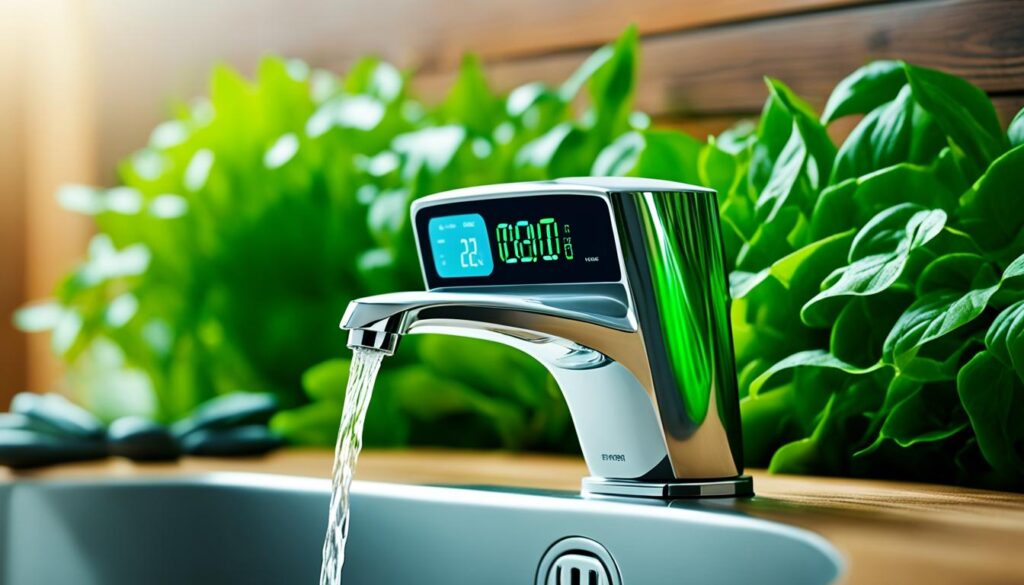
| Activity | Water Usage (Gallons) | Potential Savings |
|---|---|---|
| Shower (average) | 20 | 2,000 gallons/year by switching to showers |
| Toilet Flush (standard) | 1.6 | Replace with efficient models |
| Leaky Faucet | 30/month | Repair to save 360 gallons/year |
| ENERGY STAR Clothes Washer | 15/cycle | New models save significant amounts |
By fixing leaks and using efficient fixtures, we all can help save water in our bathrooms.
Additional Incentives for Energy-Efficient Upgrades
Getting energy-efficient upgrades is a smart move. They bring benefits both now and later. There are local incentives and energy-efficient rebates to help pay for these projects. A lot of programs from the state and federal government help homeowners. They want to make homes more energy-efficient.
Researching Local Rebates and Tax Credits
Homeowners can find great deals through local incentives. For example, Michigan’s Home Energy Rebate Programs offer big money for making your home more efficient. They have $211.1 million for rebates. Homes that save a lot of energy get these benefits. If your house uses 20% less energy, you could get help21. Families making less money might get all project costs covered. Some could get up to $14,000 back21.
The government also gives tax credits for making your home greener. With the 25C Energy Efficient Home Improvement Credit, you can get up to $3,200 back. These credits cover 30% of what you spent in a year. So, they are a big help for saving money22.
Long-Term Financial Benefits
Energy upgrades are more than just instant savings. They also make your house worth more. You can get tax credits for past work, all the way back to 201723. Making your home air-tight and getting a good HVAC system are crucial. They can stop up to 45% of energy waste22. By using local and federal help, you can save a lot while making your home better for the planet.
Conclusion
Choosing energy-efficient bathroom solutions helps us live more sustainably. It greatly cuts down on environmental harm and lowers bills. Installing low-flow toilets and showerheads can reduce water use by up to 60%. This saves a lot of resources2425. Switching to LED lighting can also decrease electricity by as much as 80%. This is compared to standard bulbs25.
Creating an eco-friendly bathroom takes careful planning. Homeowners should check insulation, get energy-efficient water heaters, and keep up with ventilation. These actions reduce energy costs and can cut greenhouse gas emissions by up to 40%24.
Investing in greener bathroom upgrades means more than improving its look. It shows a dedication to sustainability and smart living. For tips on adopting energy-saving methods at home, check out the advice available here. By choosing wisely now, we support a healthier planet. Plus, we get to enjoy the benefits of a cost-efficient bathroom.
FAQ
What features define an energy-efficient bathroom?
How can I save water in my bathroom?
What are the benefits of a green bathroom remodel?
Can I improve my bathroom’s lighting efficiency?
What is the impact of using sustainable materials?
How do I conduct an energy audit for my bathroom?
Are there any financial incentives for energy-efficient upgrades?
What smart technologies can enhance my bathroom’s energy efficiency?
Source Links
- https://www.synergycompanies.com/post/how-to-save-energy-in-the-bathroom
- https://learn.gexaenergy.com/article/tips-for-energy-efficient-bathroom
- https://prestigedistribution.com/blogs/news/commercial-bathroom-energy-efficiency-checklist
- https://www.stansac.com/blog/eco-friendly-bathroom-upgrades
- https://blog.constellation.com/2019/07/25/energy-efficient-bathroom-tips/
- https://www.dgbuildsnj.com/5-key-benefits-of-a-professional-bathroom-remodel/
- https://www.econnex.com.au/energy/blogs/ways-to-make-your-bathroom-more-energy-efficient
- https://agapehomeservices.com/top-5-energy-efficient-bathroom-remodeling-tips/
- https://blog.wolseleyexpress.com/top-energy-saving-plumbing-fixtures
- https://www.bathroomcity.co.uk/blog/top-energy-saving-ideas-your-bathroom?srsltid=AfmBOoq-qv8zOH6rgmDKskwyumg_sNac22ZzeU45JqwlLEA2DVL_DewK
- https://tubdoctorofaugusta.com/the-impact-of-sustainable-materials-on-bathroom-remodeling/
- https://www.modobath.com/inspiration/eco-friendly-bathroom-remodeling-a-step-by-step-guide/
- https://www.homedepot.com/c/ab/best-bathroom-lighting-for-your-home/9ba683603be9fa5395fab903653c721
- https://www.modobath.com/inspiration/the-art-and-science-of-bathroom-lighting-design/
- https://www.thisoldhouse.com/bathrooms/21247447/improve-bathroom-ventilation
- https://www.apge.com/blog/improving-home-energy-efficiency-with-proper-ventilation
- https://reolink.com/blog/smart-bathroom-technology/?srsltid=AfmBOoq6r_QGf3tSYJaqi1z3aV7fSA9CXUfIM_VNXInj-Xb4Su9S9Jn4
- https://www.lowes.com/n/buying-guide/smart-bathroom-updates
- https://fairvieworegon.gov/492/Saving-Water-Indoors
- https://pud-ri.org/conservation/water-conservation-tips
- https://www.michigan.gov/egle/about/organization/materials-management/energy/rfps-loans/home-energy-rebate-programs
- https://www.goettl.com/expert-center/home-ownership/federal-tax-credits-and-rebates-for-home-upgrades-everything-you-need-to-know/
- https://www.constellation.com/energy-101/homeowners-guide-tax-credits-and-rebates.html
- https://www.xscad.com/articles/4-ways-to-make-bathrooms-more-energy-efficient
- https://www.dialonesonshine.com/blog/energy-efficient-bathroom-tips-for-a-greener-home
